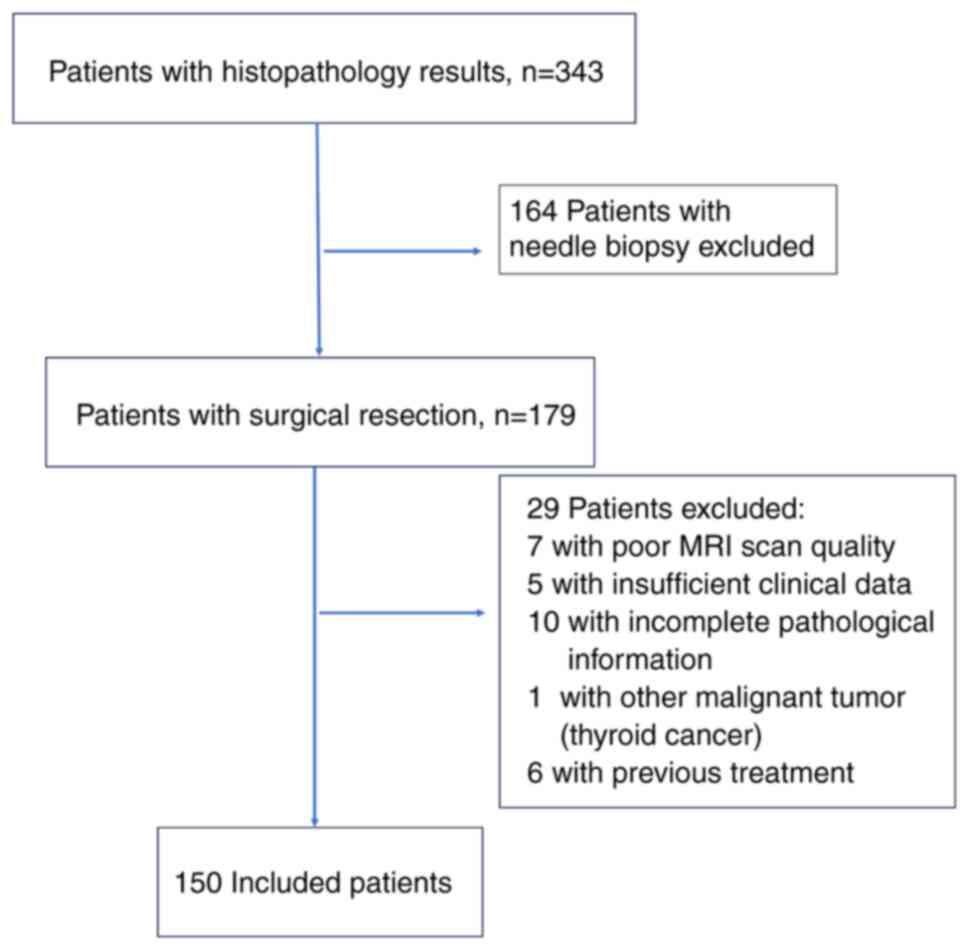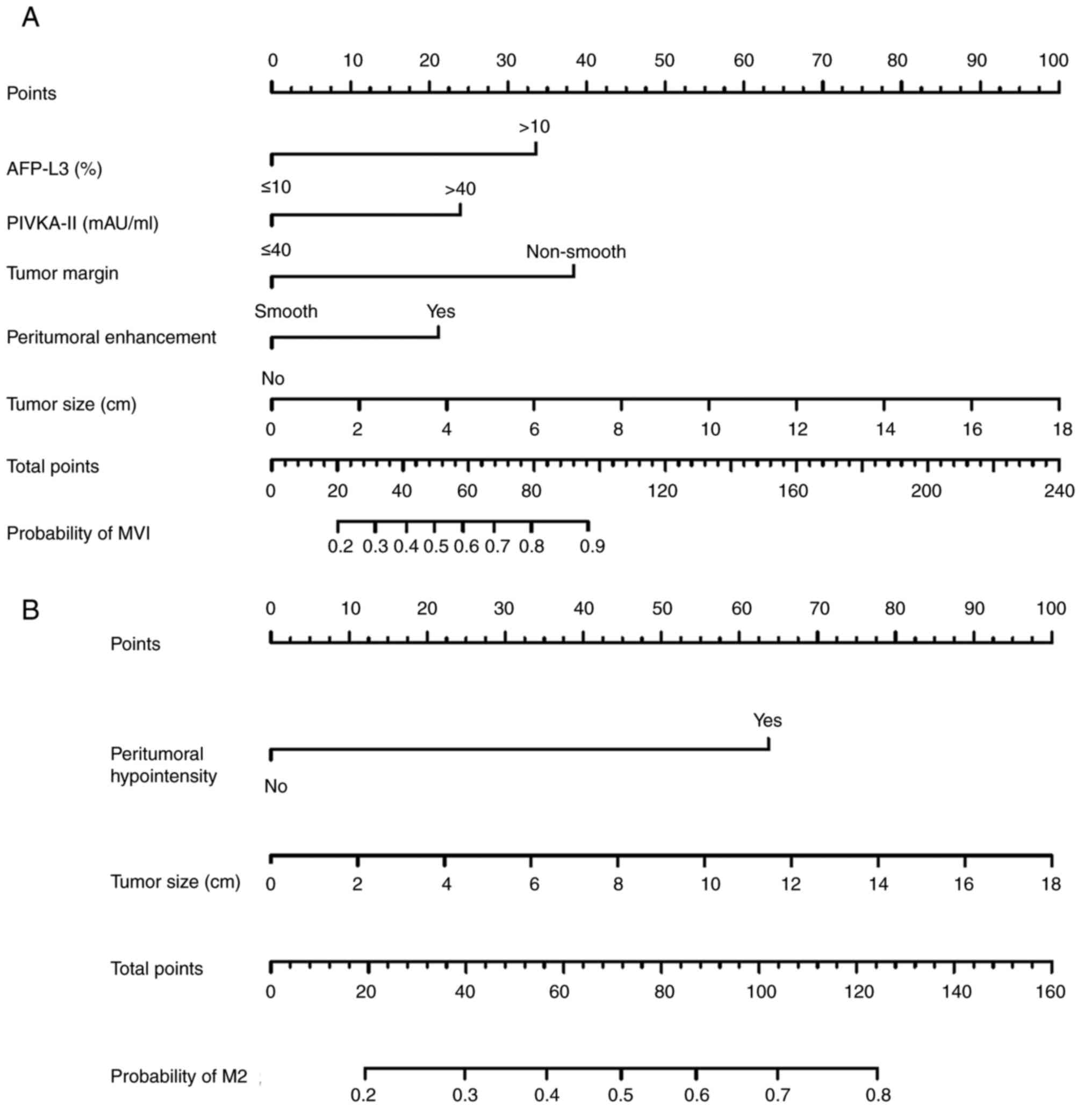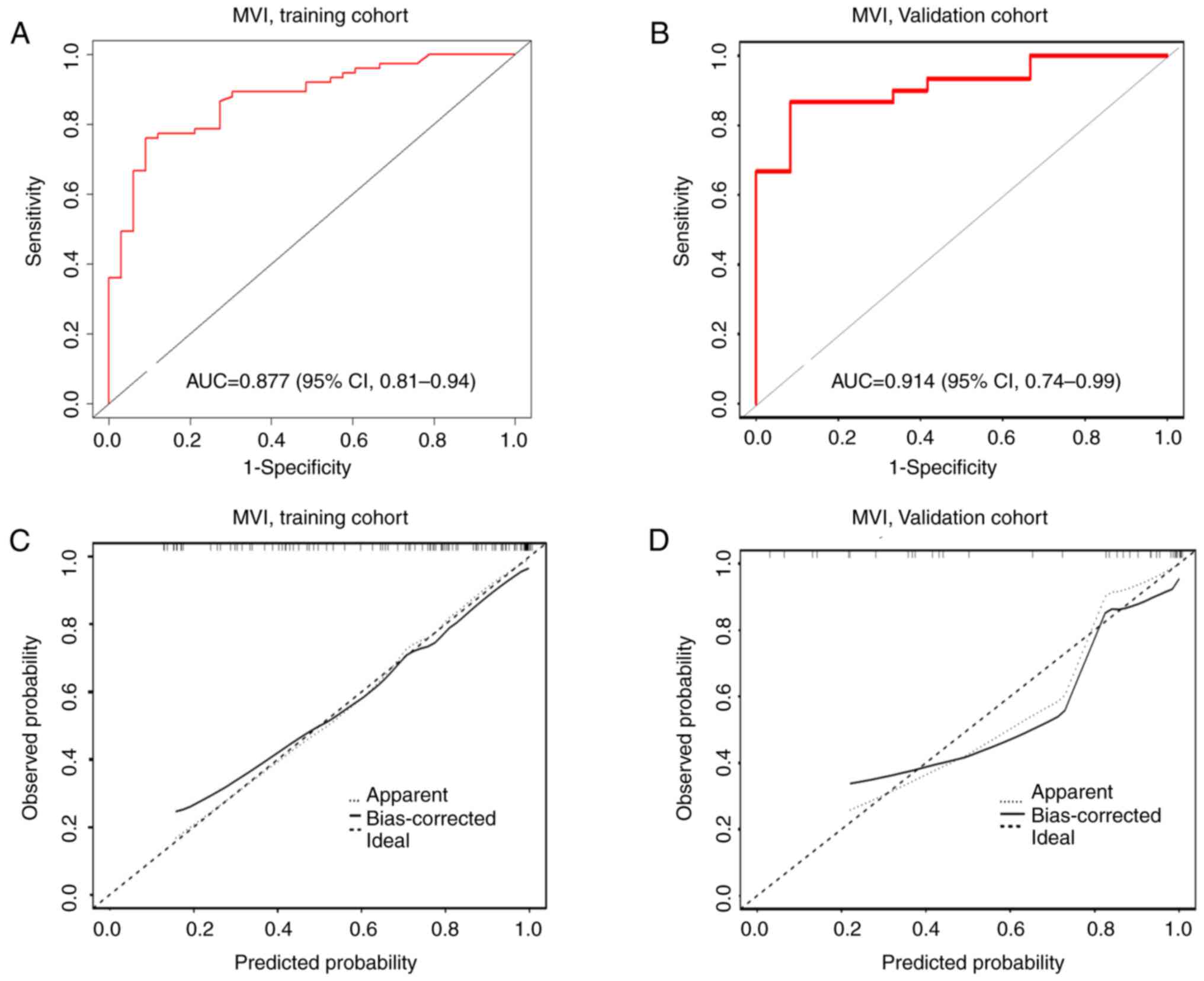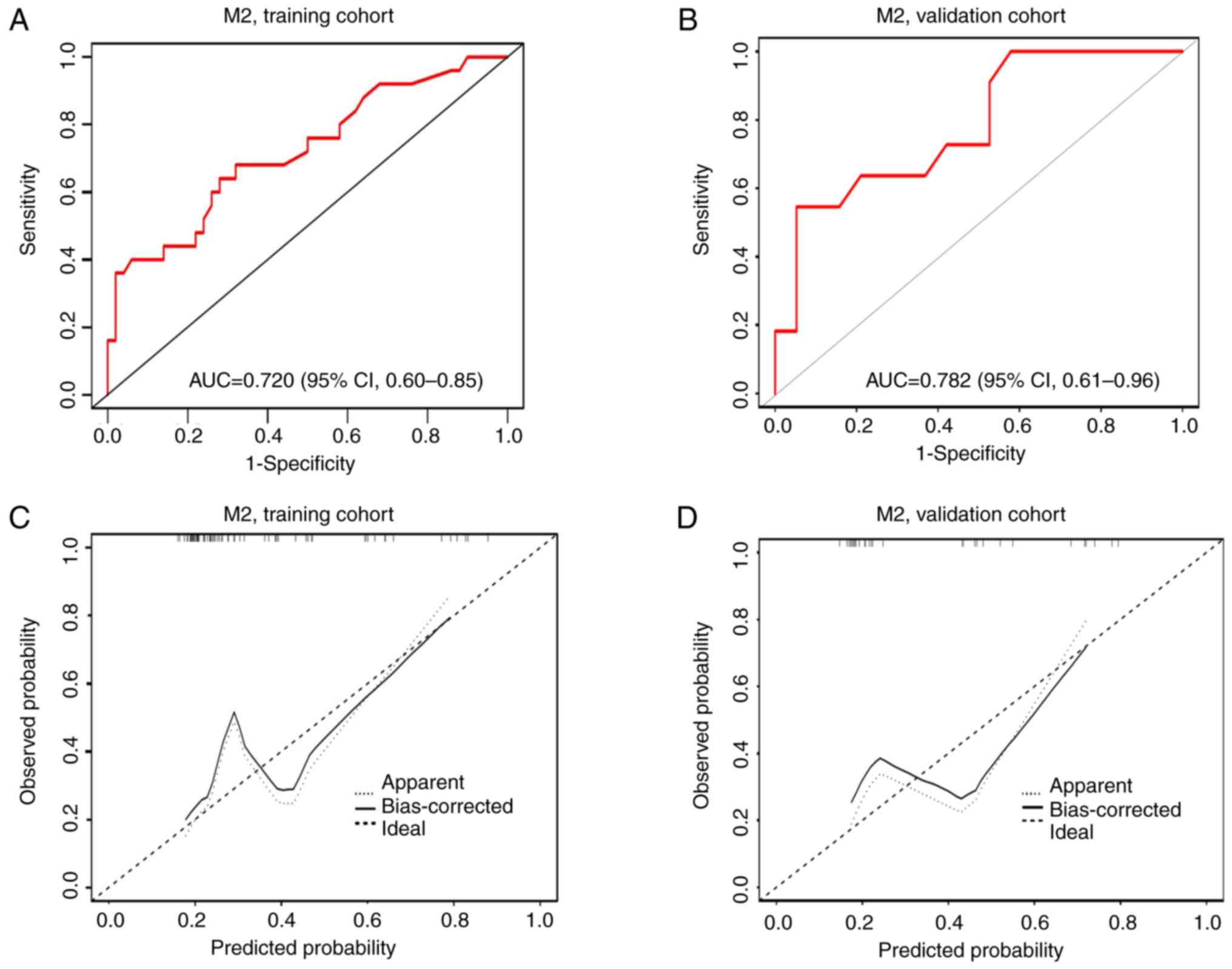|
1
|
Bray F, Ferlay J, Soerjomataram I, Siegel
RL, Torre LA and Jemal A: Global cancer statistics 2018: GLOBOCAN
estimates of incidence and mortality worldwide for 36 cancers in
185 countries. CA Cancer J Clin. 68:394–424. 2018. View Article : Google Scholar : PubMed/NCBI
|
|
2
|
Earl TM and Chapman WC: Hepatocellular
carcinoma: Resection versus transplantation. Semin Liver Dis.
33:282–292. 2013. View Article : Google Scholar : PubMed/NCBI
|
|
3
|
Chidambaranathan-Reghupaty S, Fisher PB
and Sarkar D: Hepatocellular carcinoma (HCC): Epidemiology,
etiology and molecular classification. Adv Cancer Res. 149:1–61.
2021. View Article : Google Scholar : PubMed/NCBI
|
|
4
|
Heimbach JK, Kulik LM, Finn RS, Sirlin CB,
Abecassis MM, Roberts LR, Zhu AX, Murad MH and Marrero JA: AASLD
guidelines for the treatment of hepatocellular carcinoma.
Hepatology. 67:358–380. 2018. View Article : Google Scholar : PubMed/NCBI
|
|
5
|
Kaibori M, Ishizaki M, Matsui K and Kwon
AH: Predictors of microvascular invasion before hepatectomy for
hepatocellular carcinoma. J Surg Oncol. 102:462–468. 2010.
View Article : Google Scholar : PubMed/NCBI
|
|
6
|
Wang H, Liu R, Mo H, Li R, Lian J, Liu Q
and Han S: A novel nomogram predicting the early recurrence of
hepatocellular carcinoma patients after R0 resection. Front Oncol.
13:11338072023. View Article : Google Scholar : PubMed/NCBI
|
|
7
|
Chen YD, Zhang L, Zhou ZP, Lin B, Jiang
ZJ, Tang C, Dang YW, Xia YW, Song B and Long LL: Radiomics and
nomogram of magnetic resonance imaging for preoperative prediction
of microvascular invasion in small hepatocellular carcinoma. World
J Gastroenterol. 28:4399–4416. 2022. View Article : Google Scholar : PubMed/NCBI
|
|
8
|
Cao Y, Ke R, Wang S, Zhu X, Chen J, Huang
C, Jiang Y and Lv L: DNA topoisomerase IIα and Ki67 are prognostic
factors in patients with hepatocellular carcinoma. Oncol Lett.
13:4109–4116. 2017. View Article : Google Scholar : PubMed/NCBI
|
|
9
|
Wang H, Qian YW, Wu MC and Cong WM: Liver
resection is justified in patients with BCLC intermediate stage
hepatocellular carcinoma without microvascular invasion. J
Gastrointest Surg. 24:2737–2747. 2020. View Article : Google Scholar : PubMed/NCBI
|
|
10
|
Sumie S, Nakashima O, Okuda K, Kuromatsu
R, Kawaguchi A, Nakano M, Satani M, Yamada S, Okamura S, Hori M, et
al: The significance of classifying microvascular invasion in
patients with hepatocellular carcinoma. Ann Surg Oncol.
21:1002–1009. 2014. View Article : Google Scholar : PubMed/NCBI
|
|
11
|
Wang L, Jin YX, Ji YZ, Mu Y, Zhang SC and
Pan SY: Development and validation of a prediction model for
microvascular invasion in hepatocellular carcinoma. World J
Gastroenterol. 26:1647–1659. 2020. View Article : Google Scholar : PubMed/NCBI
|
|
12
|
Lim KC, Chow PK, Allen JC, Chia GS, Lim M,
Cheow PC, Chung AY, Ooi LL and Tan SB: Microvascular invasion is a
better predictor of tumor recurrence and overall survival following
surgical resection for hepatocellular carcinoma compared to the
Milan criteria. Ann Surg. 254:108–113. 2011. View Article : Google Scholar : PubMed/NCBI
|
|
13
|
Xu X, Zhang HL, Liu QP, Sun SW, Zhang J,
Zhu FP, Yang G, Yan X, Zhang YD and Liu XS: Radiomic analysis of
contrast-enhanced CT predicts microvascular invasion and outcome in
hepatocellular carcinoma. J Hepatol. 70:1133–1144. 2019. View Article : Google Scholar : PubMed/NCBI
|
|
14
|
Lee S, Kim SH, Lee JE, Sinn DH and Park
CK: Preoperative gadoxetic acid-enhanced MRI for predicting
microvascular invasion in patients with single hepatocellular
carcinoma. J Hepatol. 67:526–534. 2017. View Article : Google Scholar : PubMed/NCBI
|
|
15
|
Lei Z, Li J, Wu D, Xia Y, Wang Q, Si A,
Wang K, Wan X, Lau WY, Wu M and Shen F: Nomogram for preoperative
estimation of microvascular invasion risk in hepatitis B
virus-related hepatocellular carcinoma within the Milan Criteria.
JAMA Surg. 151:356–363. 2016. View Article : Google Scholar : PubMed/NCBI
|
|
16
|
Ma X, Wei J, Gu D, Zhu Y, Feng B, Liang M,
Wang S, Zhao X and Tian J: Preoperative radiomics nomogram for
microvascular invasion prediction in hepatocellular carcinoma using
contrast-enhanced CT. Eur Radiol. 29:3595–3605. 2019. View Article : Google Scholar : PubMed/NCBI
|
|
17
|
Chong HH, Yang L, Sheng RF, Yu YL, Wu DJ,
Rao SX, Yang C and Zeng MS: Multi-scale and multi-parametric
radiomics of gadoxetate disodium-enhanced MRI predicts
microvascular invasion and outcome in patients with solitary
hepatocellular carcinoma ≤5 cm. Eur Radiol. 31:4824–4838. 2021.
View Article : Google Scholar : PubMed/NCBI
|
|
18
|
Cong WM, Bu H and Chen J, Dong H, Zhu YY,
Feng LH and Chen J; Guideline Committee, : Practice guidelines for
the pathological diagnosis of primary liver cancer: 2015 Update.
World J Gastroenterol. 22:9279–9287. 2016. View Article : Google Scholar : PubMed/NCBI
|
|
19
|
Chen S, Wang C, Gu Y, Ruan R, Yu J and
Wang S: Prediction of microvascular invasion and its M2
classification in hepatocellular carcinoma based on nomogram
analyses. Front Oncol. 11:7748002022. View Article : Google Scholar : PubMed/NCBI
|
|
20
|
Edmondson HA and Steiner PE: Primary
CARCINOMA OF THE LIver: A study of 100 cases among 48,900
necropsies. Cancer. 7:462–503. 1954. View Article : Google Scholar : PubMed/NCBI
|
|
21
|
Zhang S, Duan C, Zhou X, Liu F, Wang X,
Shao Q, Gao Y, Duan F, Zhao R and Wang G: Radiomics nomogram for
prediction of microvascular invasion in hepatocellular carcinoma
based on MR imaging with Gd-EOB-DTPA. Front Oncol. 12:10345192022.
View Article : Google Scholar : PubMed/NCBI
|
|
22
|
Zheng X, Xu YJ, Huang J, Cai S and Wang W:
Predictive value of radiomics analysis of enhanced CT for
three-tiered microvascular invasion grading in hepatocellular
carcinoma. Med Phys. 50:6079–6095. 2023. View Article : Google Scholar : PubMed/NCBI
|
|
23
|
Roayaie S, Blume IN, Thung SN, Guido M,
Fiel MI, Hiotis S, Labow DM, Llovet JM and Schwartz ME: A system of
classifying microvascular invasion to predict outcome after
resection in patients with hepatocellular carcinoma.
Gastroenterology. 137:850–855. 2009. View Article : Google Scholar : PubMed/NCBI
|
|
24
|
Hwang YJ, Bae JS, Lee Y, Hur BY, Lee DH
and Kim H: Classification of microvascular invasion of
hepatocellular carcinoma: Correlation with prognosis and magnetic
resonance imaging. Clin Mol Hepatol. 29:733–746. 2023. View Article : Google Scholar : PubMed/NCBI
|
|
25
|
Xu W, Li R and Liu F: Novel prognostic
nomograms for predicting early and late recurrence of
hepatocellular carcinoma after curative hepatectomy. Cancer Manag
Res. 12:1693–1712. 2020. View Article : Google Scholar : PubMed/NCBI
|
|
26
|
Yang L, Gu D, Wei J, Yang C, Rao S, Wang
W, Chen C, Ding Y, Tian J and Zeng M: A radiomics nomogram for
preoperative prediction of microvascular invasion in hepatocellular
carcinoma. Liver Cancer. 8:373–386. 2019. View Article : Google Scholar : PubMed/NCBI
|
|
27
|
Liu J, Cheng D, Liao Y, Luo C, Lei Q,
Zhang X, Wang L, Wen Z and Gao M: Development of a magnetic
resonance imaging-derived radiomics model to predict microvascular
invasion in patients with hepatocellular carcinoma. Quant Imaging
Med Surg. 13:3948–3961. 2023. View Article : Google Scholar : PubMed/NCBI
|
|
28
|
Zhang X, Ruan S, Xiao W, Shao J, Tian W,
Liu W, Zhang Z, Wan D, Huang J, Huang Q, et al: Contrast-enhanced
CT radiomics for preoperative evaluation of microvascular invasion
in hepatocellular carcinoma: A two-center study. Clin Transl Med.
10:e1112020. View Article : Google Scholar : PubMed/NCBI
|
|
29
|
Meng XP, Wang YC, Zhou JY, Yu Q, Lu CQ,
Xia C, Tang TY, Xu J, Sun K, Xiao W and Ju S: Comparison of MRI and
CT for the prediction of microvascular invasion in solitary
hepatocellular carcinoma based on a non-radiomics and radiomics
method: Which imaging modality is better? J Magn Reson Imaging.
54:526–536. 2021. View Article : Google Scholar : PubMed/NCBI
|
|
30
|
Wei JW, Jiang HY, Zeng MS, Wang MY, Niu M,
Gu DS, Chong H, Zhang Y, Fu F, Zhou M, et al: Prediction of
microvascular invasion in hepatocellular carcinoma via deep
learning: A multi-center and prospective validation study. Cancers
(Basel). 13:23682021. View Article : Google Scholar : PubMed/NCBI
|
|
31
|
Hirokawa F, Hayashi M, Miyamoto Y, Asakuma
M, Shimizu T, Komeda K, Inoue Y and Uchiyama K: Outcomes and
predictors of microvascular invasion of solitary hepatocellular
carcinoma. Hepatol Res. 44:846–853. 2014. View Article : Google Scholar : PubMed/NCBI
|
|
32
|
An C, Rhee H, Han K, Choi JY, Park YN,
Park MS, Kim MJ and Park S: Added value of smooth hypointense rim
in the hepatobiliary phase of gadoxetic acid-enhanced MRI in
identifying tumour capsule and diagnosing hepatocellular carcinoma.
Eur Radiol. 27:2610–2618. 2017. View Article : Google Scholar : PubMed/NCBI
|
|
33
|
Kim KA, Kim MJ, Jeon HM, Kim KS, Choi JS,
Ahn SH, Cha SJ and Chung YE: Prediction of microvascular invasion
of hepatocellular carcinoma: Usefulness of peritumoral
hypointensity seen on gadoxetate disodium-enhanced hepatobiliary
phase images. J Magn Reson Imaging. 35:629–634. 2012. View Article : Google Scholar : PubMed/NCBI
|
|
34
|
Force M, Park G, Chalikonda D, Roth C,
Cohen M, Halegoua-DeMarzio D and Hann HW: Alpha-fetoprotein (AFP)
and AFP-L3 is most useful in detection of recurrence of
hepatocellular carcinoma in patients after tumor ablation and with
low AFP level. Viruses. 14:7752022. View Article : Google Scholar : PubMed/NCBI
|
|
35
|
Imura S, Teraoku H, Yoshikawa M, Ishikawa
D, Yamada S, Saito Y, Iwahashi S, Ikemoto T, Morine Y and Shimada
M: Potential predictive factors for microvascular invasion in
hepatocellular carcinoma classified within the Milan criteria. Int
J Clin Oncol. 23:98–103. 2018. View Article : Google Scholar : PubMed/NCBI
|
|
36
|
Liu W, Song K, Zheng W, Huo L, Zhang S, Xu
X, Wang P and Jia N: Hepatobiliary phase features of preoperative
gadobenate-enhanced mr can predict early recurrence of
hepatocellular carcinoma in patients who underwent anatomical
hepatectomy. Front Oncol. 12:8629672022. View Article : Google Scholar : PubMed/NCBI
|
|
37
|
Kumada T, Nakano S, Takeda I, Kiriyama S,
Sone Y, Hayashi K, Katoh H, Endoh T, Sassa T and Satomura S:
Clinical utility of Lens culinaris agglutinin-reactive
alpha-fetoprotein in small hepatocellular carcinoma: Special
reference to imaging diagnosis. J Hepatol. 30:125–130. 1999.
View Article : Google Scholar : PubMed/NCBI
|
|
38
|
Miyaaki H, Nakashima O, Kurogi M, Eguchi K
and Kojiro M: Lens culinaris agglutinin-reactive
alpha-fetoprotein and protein induced by vitamin K absence II are
potential indicators of a poor prognosis: A histopathological study
of surgically resected hepatocellular carcinoma. J Gastroenterol.
42:962–968. 2007. View Article : Google Scholar : PubMed/NCBI
|
|
39
|
Wang MD, Sun LY, Qian GJ, Li C, Gu LH, Yao
LQ, Diao YK, Pawlik TM, Lau WY, Huang DS, et al: Prothrombin
induced by vitamin K Absence-II versus alpha-fetoprotein in
detection of both resectable hepatocellular carcinoma and early
recurrence after curative liver resection: A retrospective cohort
study. Int J Surg. 105:1068432022. View Article : Google Scholar : PubMed/NCBI
|
|
40
|
Hu H, Zheng Q, Huang Y, Huang XW, Lai ZC,
Liu J, Xie X, Feng ST, Wang W and Lu M: A non-smooth tumor margin
on preoperative imaging assesses microvascular invasion of
hepatocellular carcinoma: A systematic review and meta-analysis.
Sci Rep. 7:153752017. View Article : Google Scholar : PubMed/NCBI
|
|
41
|
Xu W, Wang Y, Yang Z, Li J, Li R and Liu
F: New insights into a classification-based microvascular invasion
prediction model in hepatocellular carcinoma: A multicenter study.
Front Oncol. 12:7963112022. View Article : Google Scholar : PubMed/NCBI
|
|
42
|
Wang L, Feng B, Li D, Liang M, Wang S,
Wang S, Ma X and Zhao X: Risk stratification of solitary
hepatocellular carcinoma ≤5 cm without microvascular invasion:
Prognostic values of MR imaging features based on LI-RADS and
clinical parameters. Eur Radiol. 33:3592–3603. 2023. View Article : Google Scholar : PubMed/NCBI
|
|
43
|
Lee S, Kang TW, Song KD, Lee MW, Rhim H,
Lim HK, Kim SY, Sinn DH, Kim JM, Kim K and Ha SY: Effect of
microvascular invasion risk on early recurrence of hepatocellular
carcinoma after surgery and radiofrequency ablation. Ann Surg.
273:564–571. 2021. View Article : Google Scholar : PubMed/NCBI
|
|
44
|
Jiang H, Wei H, Yang T, Qin Y, Wu Y, Chen
W, Shi Y, Ronot M, Bashir MR and Song B: VICT2 trait: Prognostic
alternative to peritumoral hepatobiliary phase hypointensity in
HCC. Radiology. 307:e2218352023. View Article : Google Scholar : PubMed/NCBI
|














